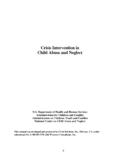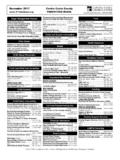Transcription of School-Based Suicide Risk Assessment, Prevention ...
1 Dianne Ballance EDPS 684 2012. INDICATED INTERVENTION. Individual interventions Individual risk assessments Dianne Ballance EDPS 684 20 1 2. Notify parents & referrals Safety or Coping plan Provide continued supervision SELECTED INTERVENTION. Identify youth at risk Use of large scale screenings Student Intervention Profile Accumulated risk model School-Based Suicide Risk Assessment, UNIVERSAL School-Based . Prevention . All students receive intervention School staff trained how to recognize & respond to signs . Prevention , &. Prevention education focuses on problem-solving & coping THE NEED TO BELONG & TO CONTRIBUTE IN S OME. WAY TO SOCIETY SEEMS TO BE AN ESSENTIAL. PART OF WHAT IT MEANS TO BE HUMAN.. Postvention THOMAS JOINER. youth Suicide Behaviour: What is it? Suicidal Ideation, Suicide -related Communication, Suicide Attempts, Suicide DEMOGRAPHICS. Risk Factors & Warning Signs Suicide is the 3rd leading cause of death among adolescents ages 15-19, and the 4th leading RISK FACTORS (can be used for identification) WARNING SIGNS cause of death among youth ages 10-14.
2 Combination of genetic, neurobiological, social, May indicate the increased probability of sui- cultural, and psychological influences. They predis- cidal behaviour. They are more immediate in Caucasian youth have the high- pose an individual to suicidal behaviour and are time and are typically more dynamic. est numbers of Suicide , but proportionally Native Americans more distant in time. Hopelessness are higher. Typically longstanding & unchangeable Rage, anger, seeking revenge GIRLS ATTEMPT 2/3 times more Presence of 1 or more mental health disorder Engaging in risky activities or acting than boys, but BOYS DIE 4/5. recklessly Previous suicidal behaviour (especially times more than girls (consistent Feeling trapped (feel there is no way out) pattern across ethnicity & age). attempts). Social isolation &/or bullying Increasing alcohol or drug use Suicide rate increases as youth Limited access to mental health facilities Withdrawal from friends, family, or society get older.
3 Poor problem-solving & coping skills Experiencing anxiety &/or agitation SEXUAL MINORITIES are at greater Low self-esteem Being unable to sleep or sleeping exces- risk for ideation & attempts sively Dysfunctional parenting or family environments RURAL areas & LOW SES have Dramatic mood changes or parental psychopathology higher rates of Suicide Perceiving no reason for living behaviour. Repeated engagement in or exposure to violence *SITUATIONAL CRISES, STRESSFUL LIFE EVENTS MAY TRIGGER . 90% of youth who have died by Access to lethal weapons Suicide would have qualified as SUICIDAL BEHAVIOUR IN VULNDERABLE INDIVIDUALS (increase risk) having a mental illness. Cultural or religious beliefs INTERPERSONAL-PSYCHOLOGICAL THEORY OF Suicide BEHAVIOUR. A youth has both the desire as well as the capacity to die by Suicide . Desire is developed by perceived burdensomeness and failed belongingness.
4 The view that one's existence burdens family, friends, and/or society, and that one is alienated from others and not an integral part of a family, circle of friends, or other valued groups are potentially fatal misperceptions. Capacity is developed through past pain and provocation that habituate an individual to the fear and pain of self-injury. In varying degrees any experience that produces substantial pain and/or fear may further this habituation process (injury, accidents, violence, daredevil behaviours). IMPLICATIONS: Emphasis of interventions should be on interpersonal contact (target perceived burden- someness & failed belonging which are more malleable). Combine symptom based screening with theory-based screening. Material on warning signs should be considered for Prevention protocols Underscores importance of creative positive, genuine, & meaningful connections between students and school personnel Dianne Ballance EDPS 684 2012.
5 Conducting Risk C OMMON. Assessments in MYTHS. About youth Schools Su icide PRIMARY PURPOSES: 1) To determine if a student is potentially suicidal (& if so to what extent). 2) Link assessment results with interventions that will best meet student's needs. INDIVIDUAL STUDENT INTERVIEW. Be cognizant of developmental issues. 5 POSSIBLE RISK LEVELS May bring in another trusted adult (to make 1. Minimal Risk = no identifiable suicidal ideation. Most youths leave a student comfortable). note : Most don't! Be very specific in your language &. 2. Mild Risk = suicidal ideation (limited frequency, Suicidal youth are crazy approach intensity, duration, & specificity). or impulsive: They have Clearly inform student why interview is cognitive distortions being conducted 3. Moderate Risk = frequent suicidal ideation with December has higher Record student responses verbatim limited intensity/duration, some specificity in terms rates of Suicide : of plan , no associated intent.
6 December has LESS. *Use the interview to determine which risk Parents know of their category to place the student & act 4. Severe risk = frequent, intense, & enduring child's suicidal behaviour: accordingly. suicidal ideation, specific plan , objective markers of They DON'T. intent. Suicide is a result of *Make sure to document everything that was stress: it's the done after interview & that student is receiving 5. Extreme risk = frequent, intense, and enduring combination of stress appropriate intervention. suicidal ideation, specific plans, clear intent. plus vulnerabilities If you talk about Suicide How student currently feels Methods used in any previous attempts or question youth about it AREAS TO ASSESS. Past/current levels of: Presence or absence of suicidal plan you will put ideas into Depression Specificity & lethality of method in Suicide their head : This belief Hopelessness plan impedes Prevention &.
7 Suicidal ideation Availability of lethal progress Perceptions of burdensomeness & means If someone wants to die belongingness Possibility of rescue by Suicide there is little History of drug use/abuse Current support anyone can do to stop it: Current problems/stressors at home, systems it actually INCREASES. school Reasons to live knowledge & referrals, &. History of and previous Suicide attempt(s) CHANGES ATTITUDES. UNIVERSAL PROGRAMS. PRINCIPLES OF EFFECTIVE PROGRAMS. Reinforce protective factors while reducing risk factors Provides students with accurate information Teaches problem-solving & coping skills There are reliable and valid screening & assessment measures available (SIQ). Theory-driven & evidence-based Emphasize behaviour change as well as promote personal/social competencies Recognize importance of multiple environmental influences Foster connections to adults & prosocial peers Permits flexible approaches to fit the needs, preferences, & values of population Evaluate & modified as needed Implemented properly & effectively Teaches students how and where to get help Improve school climate, school satisfaction, & school connectedness Dianne Ballance EDPS 684 2012.
8 Selected interventions The only good assessment is one that results in an P ROTECTIVE. effective intervention. Frank Gresham FACTORS. AT-RISK STUDENTS. INCREASE CONNECTEDNESS HIGH RISK STUDENTS. Check & Connect Program Remove access to all lethal means Structured extracurricular activities Keep student safe Increase positive interactions between Break confidentiality staff & students Use commitment to treatment statements Notify parents/guardians FOR DEPRESSION & Notify police & other community supports HOPELESSNESS Documentation Penn Resiliency Program Prepare for the student's return to school Increasing contact Cognitive Behavioural Strategies - cognitive restructuring RECOMMENDED RESOURCES. Social problem-solving and - disputing irrational thoughts American Association of Suicidology - attribution retraining Sources of Strength Program coping skills - self-monitoring & self-control SOS Signs of Suicide Screening training Suicide Prevention Resource Center (SPRC) High self-esteem Crisis Centre BC - increasing engagement in Canadian Association for Suicide Prevention Social support from both pleasant activities River of Life Program peers & parents Applied Suicide Intervention Skills Training (ASIST) Being connected.
9 POSTVENTION GUIDELINES. High self-efficacy plan in advance of any crisis; review guidelines from professional organizations (such as NASP, CPA, BCASP). Close peer friendships Have the school crisis team meet or communicate as soon as possible following a High levels of engagement Suicide to make plans & assign duties. in productive activities ( , Verify and confirm that a Suicide occurred. Communicate with medical examiner, coroner, or family of the deceased. school). POSTVENTION. Do not dismiss school or encourage funeral attendance during school hours, BUT let Warm relationship and students know they can attend funeral with parental approval. DO ensure that school staff members attend the funeral to support the affected guidance from adults students as well as the family of the Suicide victim. Dedicate a living memorial rather than a physical one. Contact the family and offer condolences and support.
10 Appraise the family of how the school is responding. Disseminate information about the Suicide to students in classrooms or in small groups. Be truthful but avoid unnecessary explicit details or focusing on why the Suicide happened. Recognize that different students will react in different ways ( , shock, depression, anger). Try to focus students on general factors in Suicide Prevention , focusing on coping skills, and let students know about community supports. Monitor close friends & classmates of the Suicide victim, meet with them individually. Arrange for makeshift counseling rooms available so that mental health professionals can meet privately with students and school personnel. Collaborate with media, law enforcement, & community agencies (emphasize help is available & no one thing is to blame. Provide follow-up services to those most affected & be aware of anniversary dates (birthday, death).)





